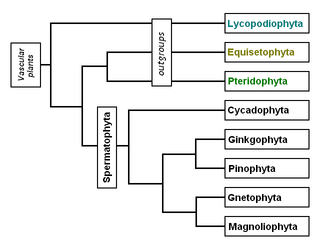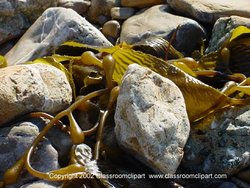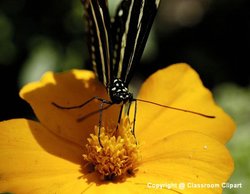Plant
|
|
| Plants | ||||
|---|---|---|---|---|
| Scientific classification | ||||
| ||||
| Divisions | ||||
|
Plants are a major group of living things (about 300,000 species), including familiar organisms such as trees, flowers, herbs, and ferns. Aristotle divided all living things between plants, which generally do not move or have sensory organs, and animals. In Linnaeus' system, these became the Kingdoms Vegetabilia (later Plantae) and Animalia. Since then, it has become clear that the Plantae as originally defined included several unrelated groups, and the fungi and several groups of algae were removed to new kingdoms. However, these are still often considered plants in many contexts. Indeed, any attempt to match "plant" with a single taxon is doomed to fail, because plant is a vaguely defined concept unrelated to the presumed phylogenic concepts on which modern taxonomy is based.
| Contents |
Embryophytes
- See main article at Embryophytes
Most familiar are the multicellular land plants, called embryophytes. They include the vascular plants, plants with full systems of leaves, stems, and roots. They also include a few of their close relatives, often called bryophytes, of which mosses are the most common.
All of these plants have eukaryotic cells with cell walls composed of cellulose, and most obtain their energy through photosynthesis, using light and carbon dioxide to synthesize food. About 300 plant species do not photosynthesize but are parasites on other species of photosynthetic plants. Plants are distinguished from green algae, from which they evolved, by having specialized reproductive organs protected by non-reproductive tissues.
Bryophytes first appeared during the early Palaeozoic. They can only survive in moist environments, and remain small throughout their life-cycle. This involves an alternation between two generations: a haploid stage, called the gametophyte, and a diploid stage, called the sporophyte. The sporophyte is short-lived and remains dependent on its parent.
Vascular plants first appeared during the Silurian period, and by the Devonian had diversified and spread into many different land environments. They have a number of adaptations that allowed them to overcome the limitations of the bryophytes. These include a cuticle resistant to desiccation, and vascular tissues that transport water throughout the organism. In many, the sporophyte acts as a separate individual, while the gametophyte remains small.

The first primitive seed plants, Pteridosperms (seed ferns) and Cordaites, both groups now extinct, appeared in the late Devonian and diversified through the Carboniferous, with further evolution through the Permian and Triassic periods. In these, the gametophyte stage is completely reduced, and the sporophyte begins life inside an enclosure called a seed, which develops while on the parent plant, and with fertilization by means of pollen grains. Whereas other vascular plants, such as ferns, reproduce by means of spores and so need moisture to develop, some seed plants can survive and reproduce in extremely arid conditions.
Early seed plants are referred to as gymnosperms (naked seeds), as the seed embryo is not enclosed in a protective structure at pollination, with the pollen landing directly on the embryo. Four surviving groups remain widespread now, particularly the conifers, which are dominant trees in several biomes. The angiosperms, comprising the flowering plants, were the last major group of plants to appear, emerging from within the gymnosperms during the Jurassic and diversifying rapidly during the Cretaceous. These differ in that the seed embryo is enclosed, so the pollen has to grow a tube to penetrate the protective seed coat; they are the predominant group of flora in most biomes today.
Algae and Fungi
The algae comprise several different groups of organisms that produce energy through photosynthesis. The most conspicuous are the seaweeds, multicellular algae that often closely resemble terrestrial plants, found among the green, red, and brown algae. These and other algal groups also include various single-celled creatures and forms that are simple collections of cells, without differentiated tissues. Many can move about, and some have even lost their ability to photosynthesize; when first discovered, these were considered as both plants and animals.The embryophytes developed from green algae; the two are collectively referred to as the green plants or Viridaeplantae. The kingdom Plantae is now usually taken to mean this monophyletic group, as shown above. With a few exceptions among the green algae, all such forms have cell walls containing cellulose and chloroplasts containing chlorophylls a and b, and store food in the form of starch. They undergo closed mitosis without centrioles, and typically have mitochondria with flat cristae.
The chloroplasts of green plants are surrounded by two membranes, suggesting they originated directly from endosymbiotic cyanobacteria. The same is true of the red algae, and the two groups are generally believed to have a common origin. In contrast, most other algae have chloroplasts with three or four membranes. They are not in general close relatives of the green plants, acquiring chloroplasts separately from ingested or symbiotic green and red algae.
Unlike embryophytes and algae, fungi are not photosynthetic, but are saprophytes: they obtain their food by breaking down and absorbing surrounding materials. Most fungi are formed by microscopic tubes called hyphae, which may or may not be divided into cells but contain eukaryotic nuclei. Fruiting bodies, of which mushrooms are the most familiar, are actually only the reproductive structures of fungi. They are not related to any of the photosynthetic groups but are close relatives of animals.
Importance
The photosynthesis and carbon fixation conducted by land plants and algae are the ultimate source of energy and organic material in nearly all habitats. These processes also radically changed the composition of the Earth's atmosphere, which as a result contains a large proportion of oxygen. Animals and most other organisms are aerobic, relying on oxygen; those that do not are confined to relatively few, anaerobic environments.
Much of human nutrition depends on cereals. Other plants that are eaten include fruits, vegetables, herbs, and spices. Some vascular plants referred to as trees and shrubs, produce woody stems and are an important source of building material. A number of plants are used decoratively, including a variety of flowers.
Growth
Simple plants like algae may have short life spans as individuals, but their populations are commonly seasonal. Other plants may be organized according to their seasonal growth pattern:
- Annual: live and reproduce within one growing season.
- Biennial: live for two growing seasons; usually reproduce in the second year.
- Perennial: live for many growing seasons; continue to reproduce once mature.
Among the vascular plants, perennials include both evergreens that keep their leaves the entire year, and deciduous plants which lose their leaves for some part. In temperate and boreal climates, they generally lose their leaves during the winter; many tropical plants lose their leaves during the dry season.
The growth rate of plants is extremely variable. Some mosses grow less than 1 μm/h, while most trees grow 25-250 μm/h. Some climbing species, such as kudzu, which do not need to produce thick supportive tissue, may grow up to 12500 μm/h.
Fossils
Plant fossils include roots, wood, leaves, seeds, fruit, pollen, spores and amber (the fossilized resin produced by some plants). Fossil land plants are recorded in terrestrial, lacustrine, fluvial and nearshore marine sediments. Pollen, spores and algae (dinoflagellates and acritarchs) are used for dating sedimentary rock sequences. The remains of fossil plants are not as common as fossil animals, although plant fossils are locally abundant in many regions worldwide.
Early fossil plants are well known from the Devonian period, including the chert of Rhynie in Aberdeenshire, Scotland. The best-preserved examples, from which their cellular construction has been described, have been found at this locality. The preservation is so perfect that sections of these ancient plants show the individual cells within the plant tissue. The Devonian period also saw the evolution of what many believe to be the first modern tree, Archaeopteris. This fern-like tree combined a woody trunk with the fronds of a fern but produced no seeds.
The Coal Measures are a major source of Palaeozoic plant fossils, with many groups of plants in existence at this time. The spoil heaps of coal mines are the best places to collect; coal itself is the remains of fossilized plants, though structural detail of the plant fossils is rarely visible in coal. In the Fossil Forest at Victoria Park in Glasgow, Scotland, the stumps of Lepidodendron trees are found in their original growth positions.
The fossilized remains of conifer and angiosperm roots, stems and branches may be locally abundant in lake and inshore sedimentary rocks from the Mesozoic and Caenozoic eras. Sequoia and its allies, magnolia, oak, and palms are often found.
Petrified wood is common in some parts of the world, and is most frequently found in arid or desert areas where it is more readily exposed by erosion. Petrified wood is often heavily silicified (the organic material replaced by silicon dioxide), and the impregnated tissue is often preserved in fine detail. Such specimens may be cut and polished using lapidary equipment. Fossil forests of petrified wood have been found in all continents.
Fossils of seed ferns such as Glossopteris are widely distributed throughout several continents of the southern hemisphere, a fact that gave support to Alfred Wegener's early ideas regarding Continental drift theory.









